This is a Konica FS, a 35mm single lens reflex camera made by Konishiroku Photo Industries, Ltd in Tokyo, Japan between 1961 and 1964. The Konica FS was the follow-up to the poor selling, but highly innovative Konica F from 1960. It was a simpler camera without an exposure meter or the Konica F’s moving film plane feature, and was limited to a 1/1000 top shutter speed, but shared the same Konica F bayonet. It’s biggest claim to fame was the vertically traveling focal plane shutter which was a predecessor to the Copal Square shutter, offering what at the time was an extremely fast 1/125 flash sync speed, something very few cameras could accomplish. It was the first Konica SLR to receive widespread distribution and was moderately successful, but due to Konishiroku’s abandonment of the Konica F bayonet lens mount in 1966 with the release of the Konica Auto-Reflex, is a relatively overlooked camera by collectors and users alike.
Film Type: 135 (35mm)
Lens: 50mm f/2 Konishiroku Hexanon coated 6-elements in 5-groups
Lens Mount: Konica F Bayonet
Focus: 2 feet to Infinity
Viewfinder: Fixed SLR Pentaprism
Shutter: High Synchro Vertically Traveling Metal Focal Plane
Speeds: B, 1 – 1/1000 seconds
Exposure Meter: None
Battery: None
Flash Mount: Cold shoe and M and X Flash Sync, 1/125 X-Sync
Other Features: Self-Timer, DOF Preview
Weight: 935 grams, 751 grams (body only)
Manual: https://www.cameramanuals.org/konica/konica_fs.pdf
How these ratings work |
The Konica FS is a stripped down version of Konishiroku’s original 35mm SLR. Although it lacks many of that first camera’s neatest features, the Konica FS more closely matches that of what photographers expected from a 35mm SLR in the early 1960s. This is a very well built camera with solid construction, good ergonomics, and an excellent lens. Combined with a 1/125 flash sync speed, which was fast for the era, and a more affordable price, I am sure many people strongly considered one when these were new. At today’s collector prices, it is a bargain, and well worth picking up. | ||||||
| Images | Handling | Features | Viewfinder | Feel & Beauty | History | Age | |
| 2 | 2 | 1 | 1 | 2 | 1 | 20% | |
| Bonus | +1 for overall excellence, an excellent camera in unassuming clothing | ||||||
| Final Score | 11.8 | ||||||
History
The name Konica is used today in a variety of business applications, making products such as printers, photo copiers, and other imaging related technologies. The company that in 1965 produced this Konica FS no longer exists, and as of 2006, exited the photographic and camera industry.

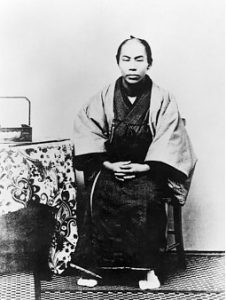
The original Konica had a long and prosperous history as the oldest Japanese camera maker. Konica could trace it’s roots all the way back to a man named Sugiura Rokusaburo who in 1873 sold pharmacy supplies in Tokyo, Japan. Sugiura launched his own pharmacy company, named Konishi Honten in 1878. In 1882, the company began producing it’s own photographic materials and selling them to other Japanese companies. Twenty years later, Konishi sold the Cherry Portable Camera, which was the very first Japanese made consumer camera.
Over the next 2 decades, Konishi Honten did very well, and in 1921 was renamed G.K. Konishiroku Honten. The company continued to be successful throughout the 1920s, releasing several other lines of cameras and even founded the Konishi College of Photography in 1923. In 1931, the company released the first ever commercially available Japanese camera lens, known as the Hexar.
Between the years of 1936 and 1943, as Japan became increasingly involved in World War II, the company’s business became reorganized and the name changed several times. At one point their entire retail and wholesale business was stopped.
After the war, the Japanese company hoped to expand their sales outside of Japan, so their name was changed once again to incorporate English, and now they were known as Konishiroku Photo Industry Co., Ltd. In 1947, the company released their first 35mm rangefinder camera, known simply as the “Konica”.
In the years after the war, many Japanese companies struggled to succeed outside of their home country as the world was not ready to put trust in Japanese made products but with Konishiroku’s strict attention to quality control and positive reputation, they eventually saw themselves in the forefront of the photographic world.
Throughout the 1950s, Konishiroku continually improved their 35mm models, even dabbling in other segments such as Twin Lens Reflexes like the Koniflex, and professional 6×7 medium format cameras like the Koni-Omega system, but like most camera makers, by the late 1950s demand was quickly growing for 35mm Single Lens Reflex cameras like the Japanese made Asahi Pentax and Miranda SLRs.
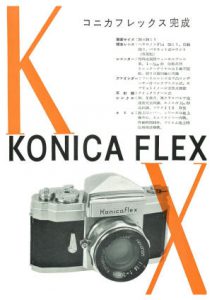
At the Tokyo International Trade Show in May 1959, Konishiroku would announce their new 35mm SLR prototype, called the Konica Flex. Based on an industry average two to three year development cycle of an all new SLR, work likely began on this camera sometime in 1956 – 57.
The new camera would have an ambitious list of features, including a coupled selenium exposure meter (behind a door on the front of the prism) with match needle visible in the viewfinder, pentaprism with a split image focus aide with Fresnel pattern for improved brightness, instant return mirror, automatic diaphragm, a metal focal plane shutter with speeds from 1 to 1/2000 and electronic flash synchronization at 1/125, a unique film pressure plate that relieves pressure off the film while advancing the film in an attempt to avoid scratching the film, self timer, and an all new bayonet lens mount with new Hexanon 7-element 50mm f/1.4 lens as standard.

Nine months later, in February 1960, the new SLR, now called the Konica F was released into production, retaining nearly all of the same features as the Konica Flex prototype. The most obvious change was the removal of the hinged door over the selenium exposure meter, and a slight revision to the standard f/1.4 lens, now measured as 52mm instead of 50mm.
The Konica F is a bit of a mystery as there are a lot of questions surrounding it’s release. It is unclear why the name of the camera was changed to Konica F. Some have theorized that the name change was to avoid confusion with the company’s Koniflex TLR, but a more likely explanation was to follow the trend of giving reflex cameras a name with “Flex” in the title.
The Konica F used a Konishiroku designed shutter that some sources online have falsely suggested was developed in cooperation with Copal. The Konica’s shutter is a completely unique design that was delicate, highly complex, and expensive to produce, and was one of the reasons the Konica F sold so poorly. Upon realizing that they could not build a line of consumer friendly SLRs using such a unique shutter, Konishiroku and a number of other Japanese companies jointly decided to work with Copal to come up with a simpler, cheaper, and more dependable design.
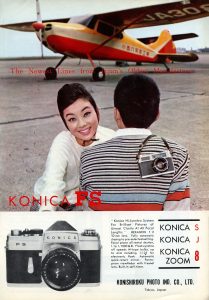
Production of the Konica F was short lived, and accurate numbers were not kept, but the best estimates are that between 1500 to 1600 examples were made, a majority of which were exported to the United States. With a retail price in 1960 with case and 52mm f/1.4 lens of $395, which when adjusted for inflation compares to $3440, the camera was extraordinarily expensive, likely making it a tough sell to American photographers.
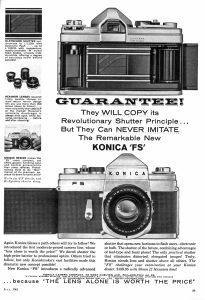
Perhaps realizing that the Konica F was too much camera for the market, in December 1960, a scaled down model called the Konica FS was released which eliminated the light meter, moving film plane, and had an improved, but simplified shutter with a top 1/1000 shutter speed. The camera was available in both chrome plated and black painted versions.
Together with a 50mm f/2 Hexanon lens, the Konica FS sold for $189.95, which was less than half the price of a Konica F and when adjusted for inflation, compares to about $1850 today!
In their marketing for the Konica FS, Konishiroku promoted the camera’s Hi-Synchro shutter as one that could never be imitated, a bold claim that would be proven to be false within a year of the camera’s release. Perhaps more accurately, the ad also uses a common Konica tagline “The Lens Alone is Worth the Price” a comment that I can definitely stand behind.
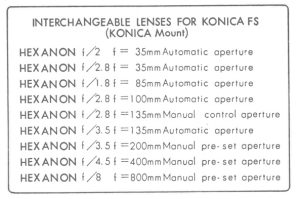
At the time of the camera’s release, a total of ten lenses (including the 50mm f/2 Hexanon) were available from 35mm all the way to 800mm. All lenses from the two 35mm lenses to one of the 135mm lenses supported an automatic diaphragm.

In earlier drafts of this review, I avoided referring to the Hi-Synchro shutter in the Konica FS as the Copal Square as all references to it in the camera’s manual and Konisiroku’s advertisement kept using the “Hi-Synchro” name. Knowing that there was a relationship between Konishiroku and Copal after the Konica F, I hypothesized that the two worked together on something that would become the Copal Square, but I could not find any definitive proof that the shutter in the camera was in fact, the Copal Square, until I stumbled upon the short review for the Konica FS in the September 1961 issue of Modern Photography that plainly says the Konica FS is the first camera to have a Copal Square shutter. This is contrary to Konishiroku’s avoidance of using the name, and other claims that the Nikkorex F was the first to use it. Further proof can be found in this Japanese language article about the Konica FS which says that later versions of black FS bodies have the words “Copal Square” printed on the shutter blades.
The rest of the review is rather straightforward, commenting on the camera’s good build quality and controls, and the excellent performance of the f/2 Hexanon lens. The review suggests that a 52mm f/1.4 Hexanon lens reviewed with the earlier Konica F was a better performer, but it appears that lens was discontinued as no reference to it is made in the camera’s manual, or the promotional pages published below.
An earlier review of the camera from the March/April 1961 issue of CamerArt reads more like a promotional report, stating the facts and nothing more. A good deal of time is spent on the new shutter, as it was likely few people at the time understood the differences or benefits of a vertically traveling shutter. Unlike the later Modern Photography review above, no mention of the shutter being made by, or in any other way related to Copal.
One last bit of promotional fare for the Konica FS comes in the two page dealer guide below, which gives a few specs of the camera, but also part numbers for the camera, available lenses, and accessories, including catalog number and price. An interesting accessory is an Exakta lens mount adapter, suggesting Konishiroku hoped that perhaps owners of Exakta cameras might see the Konica as a Japanese alternative to their existing lenses. Perhaps more interesting is that no other lens adapter is listed, because no other one would work, as the Konica F-mount’s narrow 40.5mm throat would have been too small to accept adapted M42 screw mount, Minolta SR, Nikon F, or Canon R mount lenses.
All signs pointed to the Konica FS being a success. It had a competitive feature set and a unique shutter with flash sync speed and excellent lenses and an affordable price, but competition in the Japanese camera industry at that time was fierce, with newer and more advanced models being released every few months so that meant Konishiroku couldn’t just sit still.
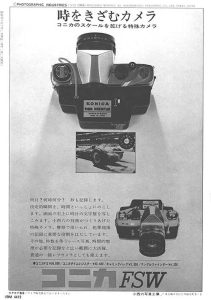
New models would soon be released such as the Konica FSW from 1962 which had one of the first implementations of a time and date data back, the slightly revised Konica FP in 1963, and the Konica FM from 1964 which had a body mounted CdS exposure meter. Constant innovation was the name of the game back then, but it wouldn’t be until 1966 when Konishiroku would make their next big splash with the Konica Auto-Reflex.
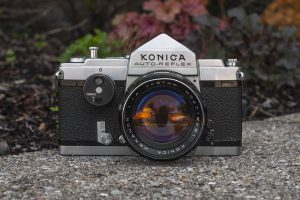
This new camera almost entirely rebooted Konica’s SLR line, featuring an all new lens mount that was not only larger, but supported aperture communication between the lens and camera allowing for open aperture metering, and eventually automatic exposure possible. The Konica Auto-Reflex retained the build quality and excellent lenses of the earlier F-mount, but used an all new Konica AR-mount and added the ability to shoot both full frame and 18mm x 24mm half frame images on the same roll of film, a feature no other interchangeable lens SLR would ever have.
Konica SLRs would enjoy a positive reputation over the years, but would unfortunately struggle to compete with other Japanese brands like Nikon, Canon, Olympus, and Minolta. Later models in the Autoreflex series offered similar features to their competitors, but by the 1980s failed to attract customers with newer, and more advanced electrically controlled cameras with features like programmed auto exposure and eventually, auto focus.
Konica would build it’s last 35mm SLR, the Konica FT-1 in 1983, only outsourcing one more model, the TC-X to Cosina in 1985. When that model was discontinued in 1987, the company would completely exit the 35mm SLR market, instead focusing on less expensive point and shoot models.
Today, Konica SLRs are hit or miss on the collector’s market. There are those who are big fan’s of the company’s lenses and buy the bodies to shoot them. In my experience, neither Konica AR nor F-mount lenses are highly desirable for people who like to digitally adapt them, so prices on the cameras and lenses are still quite reasonable. The Konica Auto-Reflex by far is the most collectible model for it’s good looks, performance, and unique full and half frame feature, leaving models like the Konica FS relatively unnoticed. These cameras can still easily be found online in good condition for under $50, making them an attractive option for budget minded collectors or film shooters.
My Thoughts
While working on my review for the Konica Auto-Reflex, I did a great deal of research into the original Konica F from 1960. I was really impressed with the amount of innovation in that camera and it’s good looks, but after learning of it’s unobtanium, I realized that the likelihood of me ever coming across one would require me to rethink ever reviewing one.
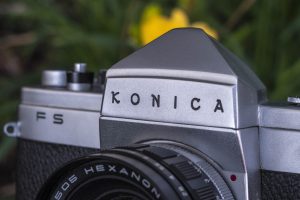
I figured that if I’m unlikely to ever find a Konica F, perhaps it’s immediate follow-up, the Konica FS would be a decent consolation. Although the Konica FS lost many of the coolest features of it’s predecessor, it was still an attractive camera that used the same lens mount would feature Konica’s excellent Hexanon lenses, so I figured, what the heck.
The Konica FS is a large and heavy all metal camera made in an era where large and heavy all metal cameras were the norm. If you’ve ever handled a 1960s Japanese SLR, you already know what to expect. This camera exudes a level of heft to suggest this was a substantial camera designed to withstand years of regular use.
I quite like the design of the Konica FS, especially the typeface for the KONICA badge in front of the prism. This logo was only used by Konica for a short while, replaced by a less original block logo. This particular camera is in excellent condition, showing very little wear to the chrome finish or body covering. Apart from a small bump near the top of the prism, if I were a Japanese eBay seller, this would be TOP MINT++++!
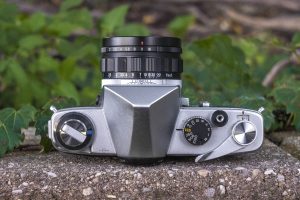
The top plate has all of the controls in the locations you’d expect to see on a 1960s Japanese SLR with one exception, being an accessory shoe that is underneath the combined rewind knob and film reminder dial. This location reminds me of where Nippon Kogaku placed the shoe for the Nikon F, requiring a special adapter to actually mount a flash or some kind of other clip on meter. Otherwise the rewind knob with fold out handle, and film reminder dial work as you’d expect.

To the right of the prism is a large black shutter speed dial with speeds from 1 to 1/1000 second plus Bulb. The setting for 1/125 is painted orange to indicate the flash X-sync speed, which for the era this camera was made, was very fast. Featuring an early version of the Copal Square shutter, the Konica FS had one of the fastest sync speeds of any SLR in an era when X-syncs of 1/30 and 1/60 were still common. The large size of the speed dial makes it easy to grip and it does not rotate when you find the shutter, like other early SLRs did. A small notch on the top of the dial is for coupling to an optional Model 4022 clip-on exposure meter made for this camera.
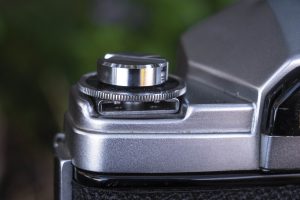
Next are the cable threaded shutter release which sits atop a black ring, the film advance lever, and exposure counter. The counter shows how many shots have been taken rather than how many are left, and automatically resets when you open the film back. The black ring below the shutter release looks like it might be a shutter lock, but doesn’t actually do anything. The film advance lever has a reasonable 180 degree swing, but must be made in one single motion, as partial motions are not possible.
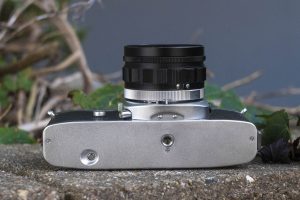
The bottom of the camera has only the rewind release button and centrally located 1/4″ tripod socket. This location for the socket is ideal as it is in the center of mass for the camera, giving it excellent balance when mounted to a tripod. The base of the mirror box extends slightly to meet the front edge of the bottom plate, giving the camera extra stability when placed on a flat surface.

Around back, there’s little to see other than the rectangular opening for the viewfinder and the camera’s serial number. The Konica FS has an interesting black metal frame around the eyepiece with two vertical grooves on either side, suggesting some eyepiece accessories such as diopters or a right angle attachment might have been available for it. The user manual makes mention of an “Angle Finder” which I assume attaches here, but there is no image of it, nor have I ever found one online.
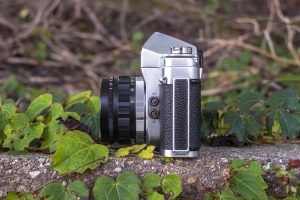
The camera’s left side has a sliding latch for opening the film compartment. Other than this latch, the two sides of the camera are the same, both with strap lugs on the front edge of the side of the camera. This forward location helps balance the weight of the camera when hanging from a strap so that it doesn’t keep falling forward. From this side of the camera, you can also see both the M and X flash sync ports on the side of the mirror box.
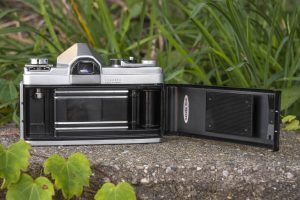
The right hinged door swings open to reveal a rather ordinary looking film compartment. Film transports from left to right onto a fixed and single slotted take up spool. A large dimpled film pressure plate is on the inside of the door to reduce friction on the film as it passes over the film gate. Inside the film gate, you can see the metal blades of the vertically traveling shutter. Although no reference is made to this being a Copal Square shutter, the shape of the connecting arms look very similar to me, suggesting there is likely more than a passing resemblance between the two. A red and silver sticker on the inside of the door says “Sakura Film” which was the brand name of Konishiroku’s 35mm film stock at the time.
Up front, the Konica FS has a mechanical self timer to the left of the lens mount that when fully wound, gives an approximate 10 second delay after pressing the shutter release. The lever can be set at a smaller interval, shortening the delay, but cannot be cancelled after it is wound.
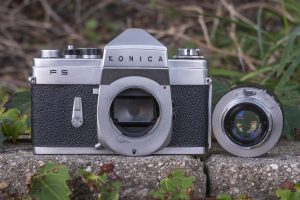
The Konica FS uses the original Konica F-mount from the original Konica F. This is not the same mount as the later Konica AR-mount released in 1966 with the Auto-Reflex. Releasing the lens requires pressing the rectangular button on the side of the mirror box near the 10 o’clock position around the lens. A quick counterclockwise twist removes the lens. With the lens off, a lens release pin is at the very bottom of the mount, and to the left of it, a comma shaped piece of metal that is the diaphragm stop down lever. All original Konica F-mount lenses had automatic diaphragms that would stop down at the moment of exposure, or could be manually stopped down by pressing a depth of field preview button near the 8 o’clock position around the lens. Installation of the lens is the opposite of removing it as a simple clockwise twist will secure it to the body.
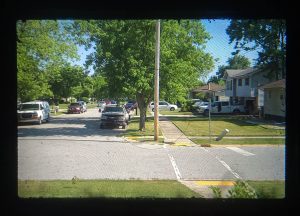
Looking through the eyepiece, the viewfinder is almost as simple as it gets. A large round ground glass circle in the center is surrounded by a noticeable Fresnel pattern which helps to improve viewfinder brightness near the edges. It works reasonably well, offering a bright and easy to use viewing screen in most shooting situations. Brightness is fairly even corner to corner, but understandably does not compare to viewing screens found on cameras from the 1970s or 80s. Other than the ground glass circle, no other focusing aides such as a split image rangefinder or microprism collar is present, nor is there any information about exposure.
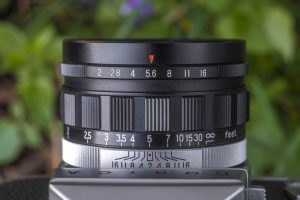
The Hexanon 50mm f/2 lens is the only Konica F-mount lens I’ve come across, but I found it to be a very nicely designed lens. The diaphragm ring is near the front edge of the lens, exactly where I prefer it. My method for shooting film is to calculate exposure first and focus later. Having the diaphragm ring near the front means I can grab it first. This ring only stops down to f/16 which is not unusual, but I would prefer to have seen an f/22 setting. It has some of the most satisfying click-stops I have ever felt or heard on a lens. The focus ring takes up the middle portion of the lens and despite this example being nearly 60 years old, was still smooth and perfectly dampened, suggesting that whatever lube was original used, still holds up well today. Finally, a chrome depth of field scale is nearest the lens mount. Although I will rarely use a depth of field scale, I found it’s location so close to the mount was partially obscured from the front of the pentaprism, requiring me to tilt the camera upward to read it.
Overall, the Konica FS is a very nice camera that handles well. Other than the strange location for the accessory shoe, there are no ergonomic surprises. The feel and build quality is superb, suggesting Konishiroku took 35mm SLRs seriously. It is disappointing that the original Konica F is so hard to find and that most of that camera’s coolest features are not present here, but what remains would have likely satisfied anyone in the market for a solid and dependable Japanese SLR in 1961.
My Results
For my first roll through the Konica FS, I chose a semi-expired roll of Fuji Neopan SS 100 which I been given to me in a bag of miscellaneous film and parts. I had never shot Neopan SS 100 before, but the day I was planning on taking it out, the weather called for dreary skies and rain so I thought the 100 speed black and white film would work well outdoors.
When writing reviews for this site, I decide how many rolls of film to shoot in a camera on a number of variables. On examples where I get flawed or otherwise lackluster images, I stop after a single roll and move on. If, on the other hand, I am so impressed with a first roll, that I want to shoot it again before writing about it to see how it performs with different film, it goes back into “the queue”.
Such was the case of the Konica FS. I was so impressed with the images from my first roll of Neopan, I took it back on in the summer of 2022 with a fresh roll of the new Fuji 200. This is the “new” Fuji that is actually made by Kodak, so I was eager to see how it compared to “old Fuji”.
Do I really need to say it? This is a Konica SLR with a Hexanon lens…of course the images look great! Sharpness, contrast, and color accuracy are excellent across the board. The quality of the optics continues to the coating, which still has it’s original bluish purple hue with no signs of yellowing due to use of radioactive materials. Even the physical construction of the lens has held up well with the focus ring nicely dampened and easy to turn. The aperture ring has some of the most satisfying click stops of any lens I’ve used.
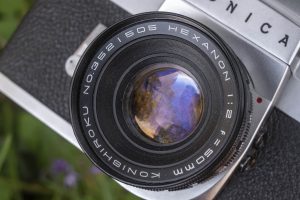
There are those that say good images are made by lenses, and that a camera body is merely a light tight box for your film, and while on some technical level, that’s true, I sincerely believe that a well designed camera with good ergonomics, a good viewfinder, and has controls in intuitive locations, will allow the photographer to use that lens better. If you struggle to see your images through a poor viewfinder, or struggle with the cameras controls while out shooting, I don’t care how good the lens is, your images will suffer.
I enjoyed picking up the Konica FS each time I shot it. As an outside observer, an easy way to tell how much I like a camera is in how fast I can finish a roll of film. In the cases of both rolls of film, I finished them very fast. Despite never having shot this model before both of these rolls, I felt that the camera was an extension of my eye, and I think that shows in the images.

It’s that reason the Konica FS is so great to shoot. There were a huge number of mechanical 35mm SLRs made in the 1960s, and almost none of them are bad, but for me, the Konica FS hits that right balance. If I had to list some nitpicks, the first would be that I wish the viewfinder was a bit brighter, and with better focus aides. While there are instances where a large ground glass circle is very helpful, but for general purpose photography, a split image with microprism collar focus aides is more useful. I would have also preferred a softer edge to the film advance lever as the tip is a bit sharp and can dig into your right thumb if you use it too quickly.
The Konica FS is a terrific camera to use that makes terrific images, but it was produced for a relatively short period of time. There’s very little wrong with the camera, but with the benefit of hindsight, we know today that the original Konica F-mount was a dead end lens mount. For starters, it was far too small. At only 40.5mm wide, it was too narrow to support wide angle lenses without vignetting, and it’s small diameter meant that it would have had a less secure connection with larger and heavier lenses. By far, larger mounts like the Nikon F and Minolta’s SR-mount were better suited to this purpose.
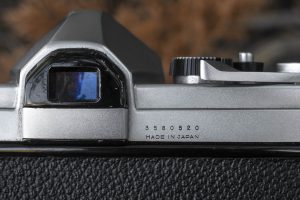
Another flaw was it’s lack of support for open aperture metering. To be fair, many early SLR mounts lacked support for this feature too, but they were easily solved with additional linkages, but I suppose Konishiroku decided that if they were going to change the mount to add this feature for what would be the upcoming Konica Auto-Reflex, they might as well start over with a whole new mount.
In the end, the Konica FS is known today as an excellent camera with a doomed mount. Thankfully, the excellence from this camera shows in the Konica Auto-Reflex, which improves on the camera with a better viewfinder, a built in meter, half frame compatibility, and of course new mount. But if you don’t need any of those, or simply cannot find an Auto-Reflex in your price range, this is absolutely a worthwhile camera to pick up.
I will definitely be shooting this camera again, and I think that if you were to give it a chance, you will be shooting it multiple times too!
Related Posts You Might Enjoy
External Links
http://camera-wiki.org/wiki/Konica_FS
https://www.hexanon.net/konica_slr_detail/konica-fs/ (in Japanese)
https://lens-db.com/camera/konica-fs-1962/
http://forum.mflenses.com/konica-f-mount-slrs-fs-fp-fm-t82171.html

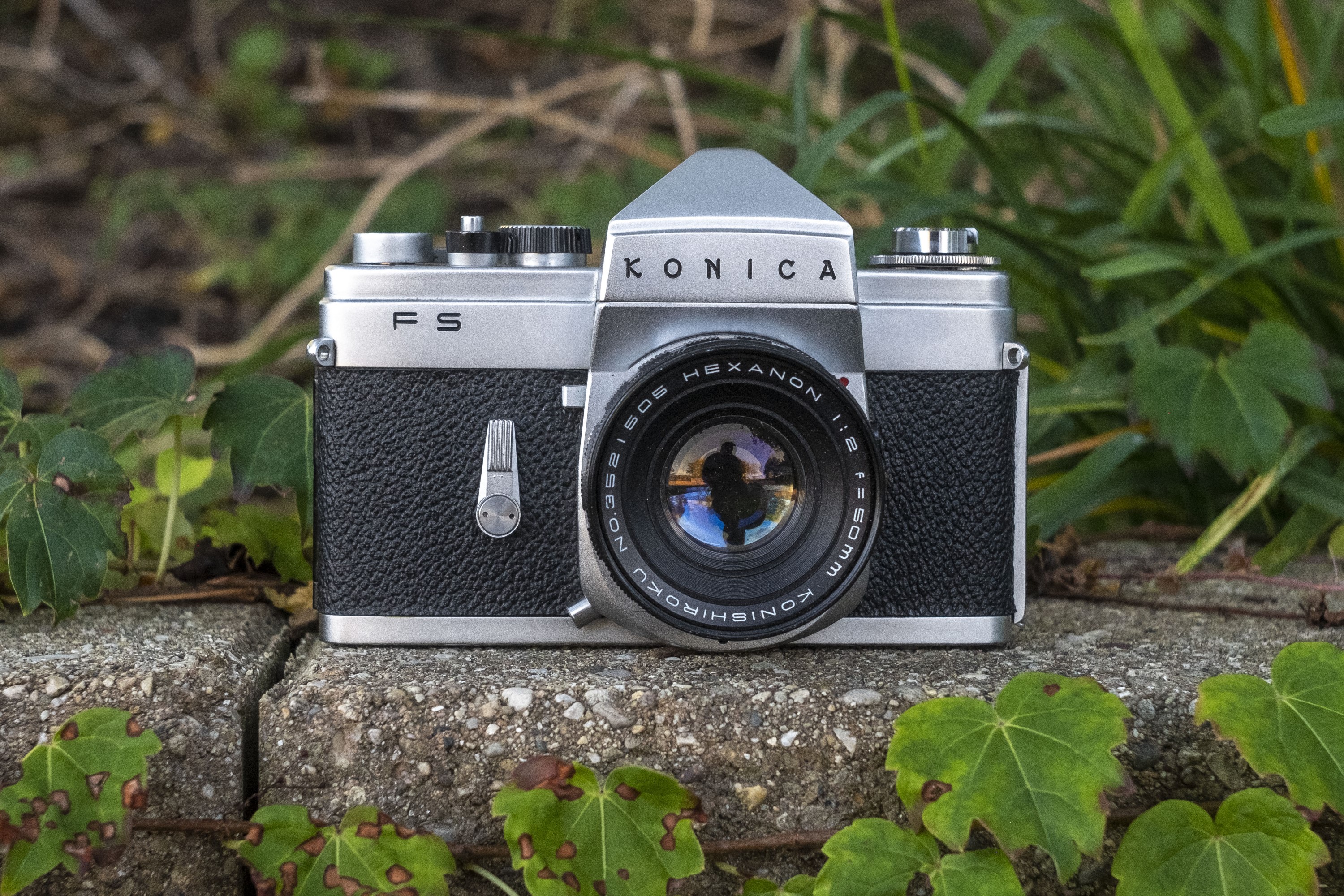
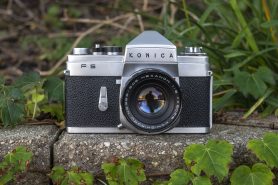
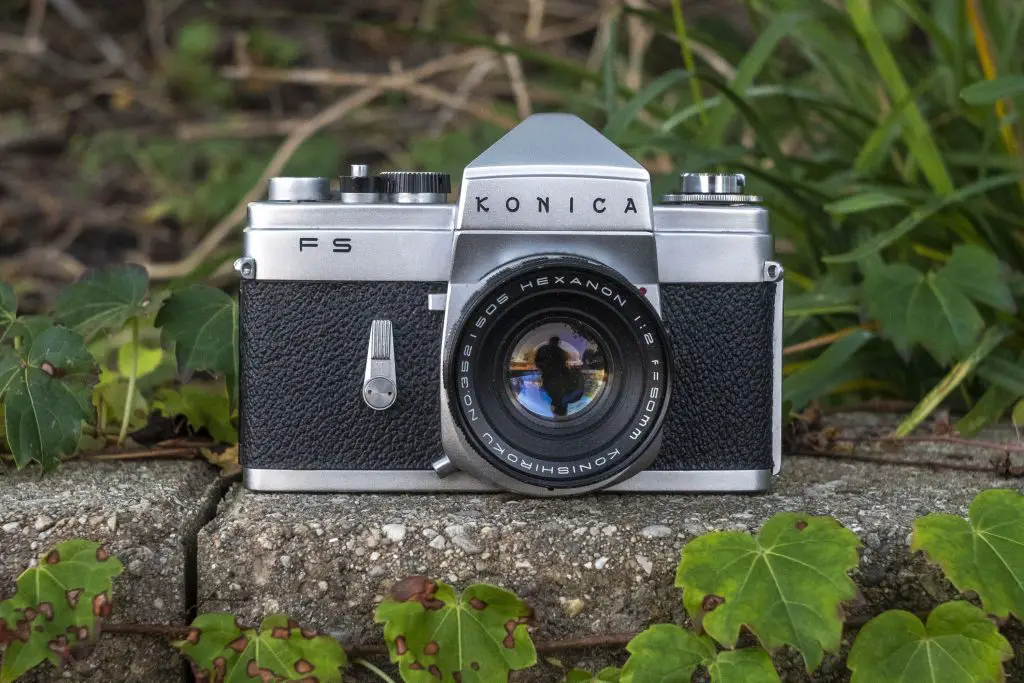
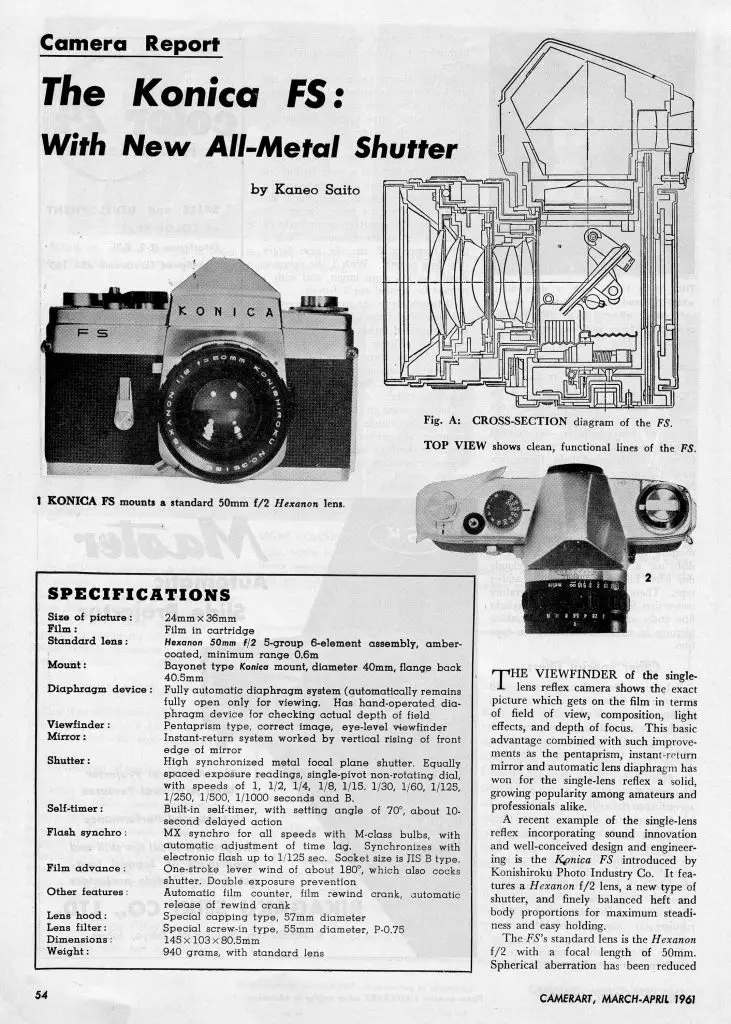

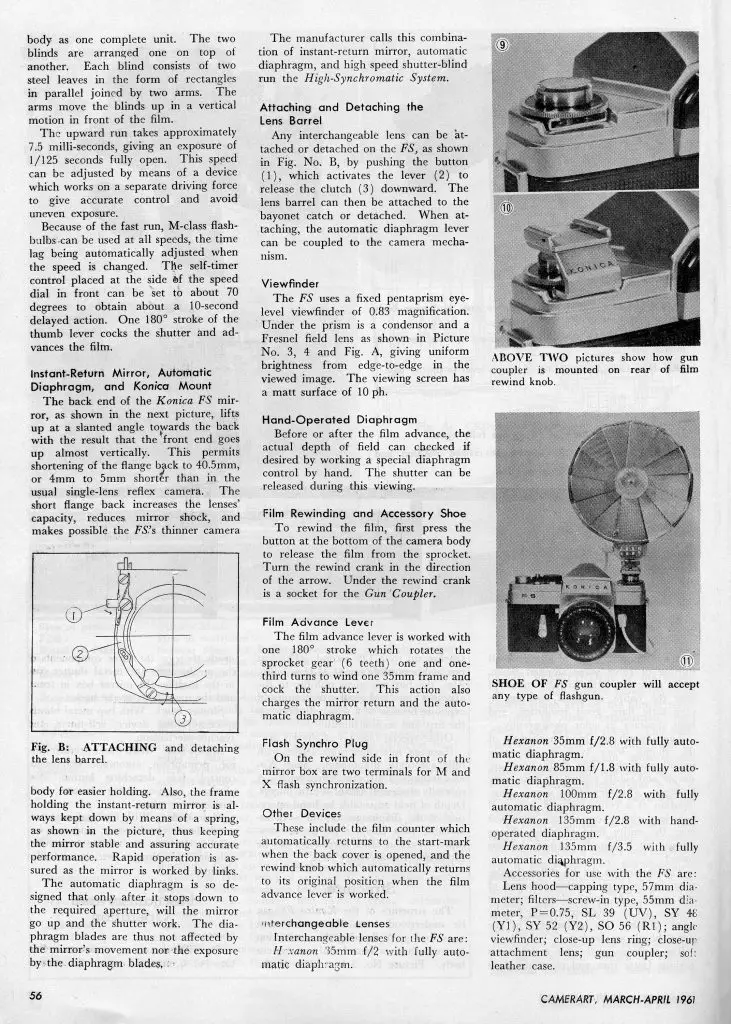

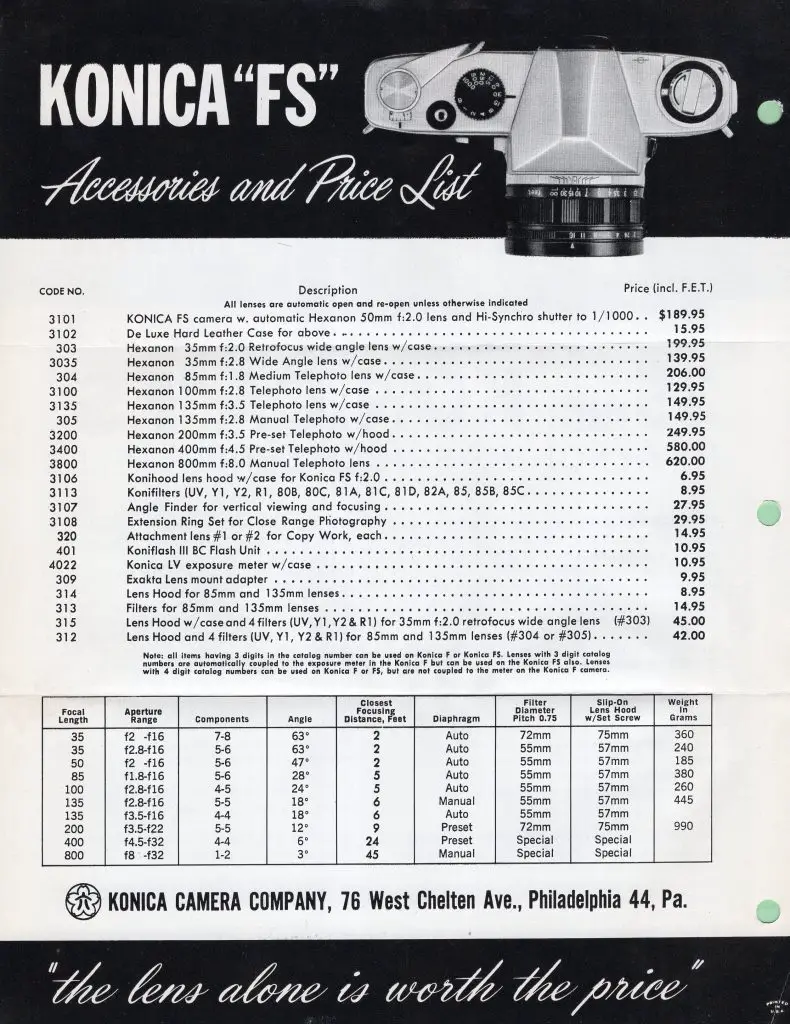











































Thanks for this, Mike – great and thorough review of a camera that was not previously on my radar! I confess to being a Konica fanboy, currently enjoying the heck out of my Autorex and Autoreflex T2 (of all the cameras I’ve used, I love the tactile experience of the T2 the most – so pleasurable!). Looks like I’ll be keeping my eyes open for an F or FS from now on!
Glad you enjoyed the review! If you like the Autorex, you should definitely like the FS. It’s a simpler camera, but works really well.
And if you ever find a Konica F, PLEASE let me know and let me borrow it as they’re very difficult to find!
I owned one of these, and agree that it handles well, but the odd design of the auto diaphragm coupler is a major weakness. It sits completely outside the lens mount, and is very easily damaged. The Auto-Reflex mount solved this for all future Konicas.
My first camera in the 60’s was the Autoreflex T and I used it for years. Did not continue with more models because they kept obsolete batteries. Hexanon lenses are still great but I went on to Canon model 1n and never changed again. Love your reviews……….David
very good review! but Hexanon.net is a Chinese language site.
I love your reviews and pictures…never heard of FS but enjoyed the review.
Thanks for the compliment David! Keep browsing the site and see what other cameras I’ve talked about which you’ve never heard of!
My copy of the FS has ‘Copal Square’ written on the shutter mechanism, exactly the same as on the Nikkorex F camera from the same era. Other people have also mentioned seeing advertisements/documentation mentioning the Copal Square shutter for the camera, indicating that the Hi-Synchro shutter mentioned in the earlier advertisements was similar in many ways to the later shutter model, with the later model perhaps having some refinement of the design but sharing many similarities in terms of dimensions. It seems clear that the change happened midway through the production run for the FS model.
I think that due to the lack of readily available adapters for Konica F lenses, these remain fairly (perhaps unfairly) obscure in the general consciousness. Their adoption of the metal shutter much earlier than other manufacturers makes their F mount cameras a great buy for budget focused classic film camera fans.
It’s nice to see you have a working copy of a FS. I’ve had several FS and FP models pass through my hands, and like others I’ve seen for sale, they all had film advance and/or mirror problems. Though nicely finished, I did not get the feeling they were quite as well designed or reliable as the Autoreflex T series, and the lenses also seemed a bit more cheaply made than the later AR lenses, with thinner aluminum focusing rings and silkscreened numbers. Clearly it’s a fine lens optically, though, as your samples show. F-mount T adapters are reasonably easy to find on eBay, for anyone interested in these early Konicas.